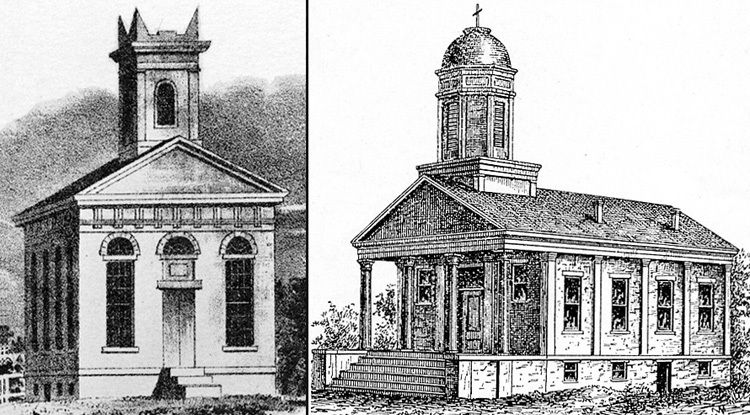Presbyterians faced off across central Iowa City during the 1840s from prominent pioneer edifices
– the 1845 Stone Church along Burlington Street at left and the 1843-1850 North Church on a site now serving Old Brick.
These 1854 drawings are by pioneer artist George Yewell.
|
By
Bob Hibbs
Despite
early support from Iowa City’s founding father, Chauncey Swan, Presbyterians
in pioneer Iowa City were a stormy bunch, spurred by elitist
Congregationalists and sharp divisions within their own ranks.
Two
years before Iowa City was founded in 1839, Presbyterians nationally split
into hostile “Old School” conservative and “New School” liberal camps.
They sponsored competing local churches, with Old Brick housing the “Old”
and a south “Stone Church” along Burlington Street housing New School
members.
In
a seemingly spiteful fit, the liberals named themselves “First
Constitutional Presbyterian Church” on organization in 1841. The “Old
School” group had been formed the previous year as “First Presbyterian
Church.” Swan and spouse Dolly contributed the north church site, which now
serves Old Brick.
A
third local Presbyterian group – the United Presbyterians – built a small
brick building on the northeast corner of the Iowa Avenue and Clinton Street
intersection, subsequent site of an 1872 Byzantine-style Universalist edifice
later used by the University of Iowa as Unity Hall. The site now serves UI’s
Phillips Hall.
During
the early 19th century eastern Congregationalists believed their flocks
couldn’t survive beyond the educated intellectual cocoon of New England
life. “Congregational pastors advised their people moving west to become
Presbyterians,” wrote Joseph Heffner in a 1916 history of the local
Congregational church.
Disaster
pummeled early local Presbyterians. At the north church a disgruntled former
pastor, Michael Hummer, returned in 1848 and climbed the unfinished belfry to
take a bell he claimed for unpaid wages.
As
Hummer lowered the bell by rope, members removed his ladder, hid the bell and
left Hummer “raving and scolding and gesticulating like a madman.” A year
later the bell went with a group headed to California and was sold to Mormons
in Salt Lake City, where it was last reported as a museum piece in 1910.
Although
his sons were members of the north church for many years, Chauncey Swan left
for California gold fields in 1849 and died about 1851 during a return voyage.
He was buried in New York Harbor.
The
six-year-old north church burned in 1856, set ablaze by embers from a
neighbor’s blacksmith shop. The wonderings of an idle mind raise the mostly
facetious question of whether the fire might have had fathers. The south
church was experiencing financial difficulties and was near dissolution;
Hummer was considered insane.
A
new cornerstone was set immediately, but it was 1865 before an edifice topped
it. Its new spire spiked 153 feet skyward, but was lost to an 1877 windstorm
and never replaced. Rather, the spire’s base was capped off with the far
shorter battlement belfry which tops Old Brick Church today.
It
now houses Lutheran and Episcopal campus ministries, including Sunday worship.
Meanwhile,
the south church, completed in 1845, housed a small group which struggled with
finances. A bell which members didn’t like was sold to UI in 1855 for a
rented Mechanics Academy where the university first held classes.
This
era also witnessed removal of the Iowa capital to Des Moines in 1857, the same
year a financial panic hit as devastatingly as the 1930s Great Depression.
The
south Presbyterian group was disbanded. Many joined in forming a new
Congregational Church in 1866. This group built the 1868 Congregational
edifice which survives today on the southeast corner of the Clinton-Jefferson
intersection.
The
south Stone Church housed the State Historical Society of Iowa from 1868
through 1884; was rented to UI as a gymnasium during the 1890s, and demolished
sometime after 1905.
P.S.
By way of disclosure, this reporter has been a member of First Presbyterian
Church since 1968, and is a past board member.
There
is a jest among members that none belongs to an organized church; being
Presbyterians.
Next
Saturday:
Cigars and local brews. Bob Hibbs collects local postcards and other historic ephemera and researches history related to them.
|
